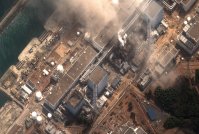PNNL team supports efforts in Fukushima
Results:

This satellite photo shows the extent of destruction of nuclear reactor units at the Fukushima Nuclear Power Station following the March 2011 earthquake and tsunami and the subsequent hydrogen explosions. Photo courtesy of DigitalGlobe.
In April 2011, two weeks following the massive earthquake and tsunami that hit Fukushima, Japan, the Japanese government was making real-time decisions in a race to stabilize the situation. In the midst of overwhelming destruction and the urgency to prevent further damage, Pacific Northwest National Laboratory was tapped to provide technical assistance to Japan. Working 18 to 20-hour days alongside their Japanese counterparts, PNNL scientists and engineers drew on PNNL's 40-plus years of experience with the Hanford Site in eastern Washington, Chernobyl, and other nuclear and environmental recovery efforts to provide direct support to the Japanese government.
Why it matters:
Prior to the disaster, Japan was the third-largest producer of nuclear power in the world, getting 30 percent of its electric energy needs from nuclear. PNNL's work with Japan is contributing to Japan's efforts to achieve a safe and stable resolution to the crisis in terms of energy production and managing radioactive contamination in Fukushima prefecture so that Japan can continue to meet its energy needs and Japanese citizens can return to their homes.
In a larger context, nuclear is an important source of carbon-free, base-load energy1 in a world where both energy needs and carbon emissions are rising. As they support the Japanese, PNNL scientists will use what they learn to help make sure that nuclear power remains a safe, viable component of the electricity mix both in the U.S. and abroad. Specifically, PNNL will provide regulatory and research and development leadership to U.S. nuclear programs in DOE's Office of Nuclear Energy and to the Nuclear Regulatory Commission.
Method:
An accident of this magnitude had never happened before—six reactors, all in the same location, were damaged by the tsunami. Three of these reactors (Units 1-3) were operating at full power when the disaster struck. The four reactors (Units 1-4) that received the brunt of the damage, have integral spent fuel pools containing significant amounts of highly radioactive spent fuel, which were also damaged by the disaster and the subsequent explosions.
Initially, PNNL staff focused on the immediate activities needed to stabilize the situation: assisting with technical plans for cooling the damaged reactors and spent fuel pools; assisting in efforts to stabilize radioactive contamination and prevent further releases; and providing technical options for securely storing and treating the rapidly accumulating volume of contaminated cooling water. "We were also asked to consider the likely condition of the spent fuel contained in the pools and the impact that the accident, along with the degraded water chemistry, might have on the spent fuel," said Wayne Johnson, director of PNNL's Earth Systems Science division. "We drew on our experience with Hanford's K Basin and work we've done internationally to help the Japanese understand what was going on within these pools."
One important concern was the transport of contaminants to the food chain. Issues such as erosion, sedimentation, bioaccumulation, and potential uptake into food crops like rice and lettuce on land, and seaweed and shellfish within the ocean made PNNL's environmental and coastal science expertise an important resource. "There are a lot of models that look at ocean currents or atmospheric transport, but radionuclides don't necessarily behave in a straightforward manner—they'll fall out, accumulate in sediment or biota, and can become a source for future dispersion," Johnson said. "We reviewed Japan's monitoring plans based on our ecological and subsurface science experience to verify whether they were taking those kinds of things into consideration."
As time passes, remediation, waste management, and long-term monitoring have become additional concerns. These areas echo PNNL's Hanford experience with fate and transport, remediation technologies, and desired land use. "Working with various Japanese government officials and scientific teams we've been able to provide valuable input into their recovery plans," Johnson said. "These recovery plans are moving forward based on stakeholder priorities and land-use needs, along with site specific data linked to possible remediation technologies, waste management approaches and long-term monitoring efforts."
What's next:
At the onset of work in Japan, PNNL was part of the U.S. Department of Energy's Nuclear Emergency Response Team (NERT). This has transitioned into a new phase of work for PNNL which is funded directly by Japan's Atomic Energy Agency and will continue to focus on each of the four areas discussed above: spent fuel pool assessments; managing the radioactively contaminated water; fate and transport of radionuclides in the environment; and remediation and long-term monitoring programs.
Acknowledgments:
Wayne Johnson continues working with PNNL management to coordinate PNNL's involvement with the government of Japan. Dr. Yasuo Onishi is PNNL's leader on the ground in Japan. Dr. Onishi, along with PNNL staff members Bruce Reid, Tom Michener, and Jeff Miller, have all spent time in Japan supporting the recovery efforts.
PNNL-SA-82487
______________1Base-load energy is the amount of energy required to meet the minimum power needs of customers in a given utility or distribution district. Nuclear energy is considered base-load because it supplies continuous power.
